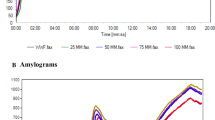Abstract
Use of extenders in meat products is not only health promoting but can also increase the economic worth of the products. Extension of the meat product is generally associated with poor binding and texture. Thus, the present study was envisaged to solve this problem by the incorporation of gum tragacanth (GT) as bind enhancing agent, used at three different levels viz., 0.1, 0.15 and 0.2 % in a pre standardized formulation of extended restructured mutton chops (ERMC), by replacing the lean meat. The products were subjected to analysis for physico-chemical, sensory and textural properties. There was no significant difference (P > 0.05) in any of the physicochemical property parameters of product incorporated with different levels of GT except fat percent and shear force value. Mean scores for binding, texture and overall acceptability of ERMC incorporated with 0.1 % GT recorded significantly higher value (P < 0.05) than control and other treatment products. On the basis of sensory scores and physico-chemical properties, the optimum incorporation level of GT was adjudged as 0.1 %. Hardness and adhesiveness values were significantly higher (P < 0.05) in product with 0.1 % GT level. The product with optimum level of GT was also assessed for water activity (aw) and microbiological characteristics. It was found that treatment as well as control products were quite acceptable up to 15th day of storage period without any marked differences in sensory quality.
Similar content being viewed by others
References
Anderson DMW, Bridgeman MME (1985) The composition of the proteinaceous polysaccharides exuded by Astragalus microcephalus, A. gummifer and A. kurdicus—the sources of turkish gum tragacanth. Phytochemistry 24(10):2301–2304
AOAC (1995) Official method of analysis, 16th edn. Association of Official Analytical Chemists, Washington, DC
APHA (1984) Compendium of method for microbiological examination of food, 2nd edn. In: Speck ML (ed) American Public Health Association, Washington DC
Azarikia F, Abbasi S (2010) On the stabilization mechanism of Doogh (Iranian yoghurt drink) by gum tragacanth. Food Hydrocoll 24:358–363
Balaghi S, Mohammadifar M, Zargaraan A (2010) Physicochemical and rheological characterization of gum tragacanth exudates from six species of Iranian Astragalus. Food Biophys 5(1):59–71
Berry BW, Stiffler DM (1981) Effect of electric stimulator boiling temperature formulation and rate of freezing on sensory cooking chemical and physical properties of ground beef patties. J Food Sci 46:1103–1106
Bourne MC (1978) Texture profile analysis. J Food Sci 32:62–67
Cremer ML, Chipley JR (1977) Satellite food service system: time and temperature and microbiological and sensory quality of precooked frozen hamburger patties. J Food Prot 40:603–607
Duncan DB (1955) Multiple range and multiple F test. Biometrics 1:1–8
FAO (2009) www.fao.org http://faostat.fao.org/site/339/default.aspx Accession date: 13th November, 2010
FDA Code of Federal Regulations (2003) In: Verbeken D, Dierckx S, Dewettinck K (eds) Exudate gums: occurrence, production, and applications. Appl Microbiol Biotechnol 63:10–21
Foroghinia S, Abbasi S, Hamidi Z (2007) Efficacy of individual and combined addition of salep, tragacanth and guar gums on stabilization of Iranian Doogh. Iran J Nutr Sci Food Technol 2:15–25
Greene BA, Cumuze TH (1982) Relationship between TBA numbers and inexperienced panelists. Assessments of oxidized flavour in cooked beef. J Food Sci 47:52–58
Jay JM (1996) Modern food microbiology, 4th edn. CBS Publishers and Distributors, New Delhi
Keeton JT (1983) Effect of fat and sodium chloride salt/phosphate level on the chemical and sensory properties of pork patties. J Food Sci 48:878–885
Levy G, Schwarz TW (1958) Tragacanth solutions I. The relation of method of preparation to the viscosity and stability. J Am Pharm Assoc 47(6):451–454
Mandal PK, Pal UK, Das CD, Rao VK (2002) Changes in the quality of restructured cured chicken during refrigerated storage. Indian J Poult Sci 37:151–154
Modi VK, Mahendrakar NS, Narasima Rao D, Sachindra NM (2003) Quality of burger containing legume flours as binders. Meat Sci 66:143–149
Mohammadifar MA, Musavi SM, Kiumarsi A, Williams PA (2006) Solution properties of targacanthin (water-soluble part of gum tragacanth exudate from Astragalus gossypinus). Int J Biol Macromol 38(1):31–39
Nath RL, Mahapatra CM, Kondaiah N, Anand SK, Singh JM (1995) Effect of level of chicken fat on the quality and storage life of chicken patties. Indian J Poult Sci 30(1):52–57
Sachdev AK, Gopal R (2000) Storage quality changes in cooked chicken rolls. Indian J Poult Sci 35:364–366
Sahoo J, Anjaneyulu ASR (1997) Effect of natural antioxidants and vacuum packaging on the quality of buffalo meat nuggets during refrigerated storage. Meat Sci 47:223–230
Snedecor GW, Cochran WG (1995) Statistical methods, 8th edn. IOWA
Sudhakar V, Singhal RS, Kulkarni PR (1996) Effects of salt on interactions of starch with guar gum. Food Hydrocoll 10(3):329–334
Tarladgis BG, Watts BM, Yaunathan MT, Dugan LR (1960) Distillation methods for the quantitative determination of malonaaldehyde in rancid foods. J Am Oil Chem Soc 37:66–71
Thomas R, Anjaneyulu ASR, Kondaiah N (2006) Quality and shelf life evaluation of emulsion and restructured buffalo meat nuggets at cold storage (4 ± 1°C). Meat Sci 72:373–379
Trout ES, Hunt MC, Johnson DE, Claus JR, Kastner CL, Kropt DH (1992) Characterstics of low fat ground beef containing texture modifying ingredients. J Food Sci 57(1):19–24
Varela P, Fiszman SM (2011) Hydrocolloids in fried foods. Food Hydrocoll 25:1801–1812
Verbeken D, Dierckx S, Dewettinck K (2003) Exudate gums: occurrence, production, and applications. Appl Microbiol Biotechnol 63:10–21
Watts BM (1962) Meat products. Symposium on food lipids and their oxidation. AVI Pub. Co. Inc, Westport, p 202
Weiping W, Branwell A (2000) Tragacanth and Karaya. In: Phillips GO, Williams PA (eds) Handbook of hydrocolloids. Woodhead Publishing Ltd, Cambridge
Author information
Authors and Affiliations
Corresponding author
Rights and permissions
About this article
Cite this article
Sharma, H., Sharma, B.D., Talukder, S. et al. Utilization of gum tragacanth as bind enhancing agent in extended restructured mutton chops. J Food Sci Technol 52, 1626–1633 (2015). https://doi.org/10.1007/s13197-013-1172-y
Revised:
Accepted:
Published:
Issue Date:
DOI: https://doi.org/10.1007/s13197-013-1172-y




